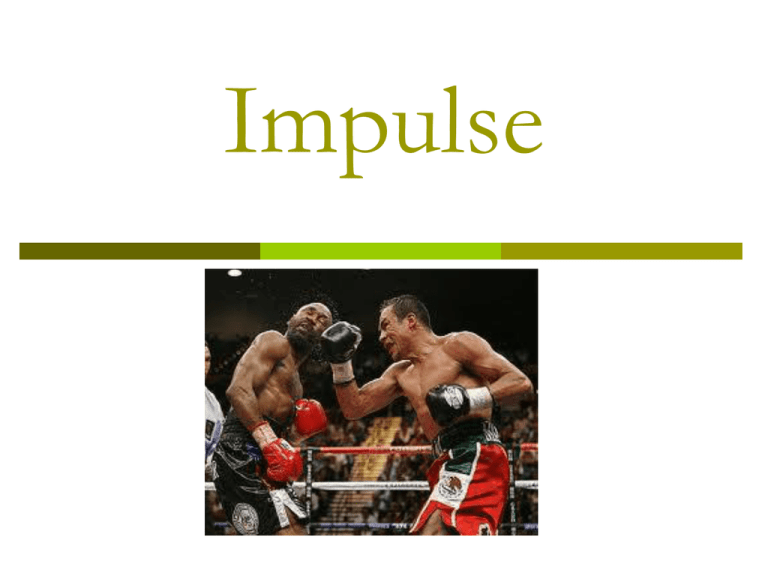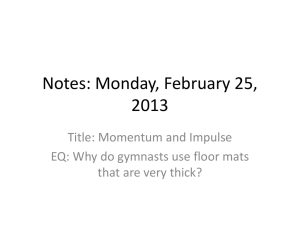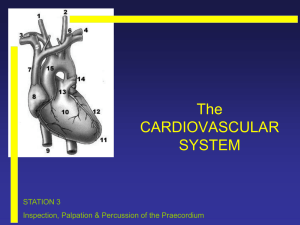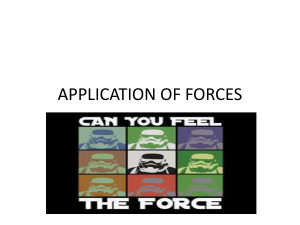Impulse and Collisions
advertisement

Impulse Impulse In certain martial arts, people practice breaking a piece of wood with the side of their bare hand. How can this be done without injury to the hand? Impulse A change in momentum created by a force exerted over time is called impulse. Basically, impulse is a change in momentum. Impulse If the momentum of an object changes, either the mass or the velocity or both change Impulse Which do you think is more likely to change: the mass of an object, or the velocity of an object? Impulse If the mass remains unchanged, which is most often the case, then the velocity changes and WHAT occurs? Impulse Acceleration Impulse What produces acceleration? Impulse Force Impulse The greater the force acting on an object, the greater its change in velocity, and therefore, the greater its change in momentum Impulse How long the force acts is also important. If you apply a brief force to a stalled car you changed the car’s momentum. Impulse If you applied the same force over an extended period of time you will produce a greater change in the car’s momentum. Impulse A force sustained for a longer time produces more change in momentum than does the same force applied briefly. Impulse BOTH Force and Time are important in changing momentum. Impulse In physics, the quantity Force • time is known as impulse. Impulse Impulse = change in momentum This is how it looks on your STAAR chart: Units? Impulse Impulse - examples In certain martial arts, people practice breaking a piece of wood with the side of their bare hand. How can this be done without injury to the hand? Using your new found understanding of impulse, what is your answer to this question now? Impulse - examples In order to break wood with the hand, a large force is applied in a short time. If the hand bounces, an even greater impulse is applied because there is a greater change in momentum. The martial artist must take care to strike the wood with the fleshy side of the hand so that there is a smaller force applied to the hand than there would be if the fingers or knuckles were to hit the piece of wood. Impulse - examples An egg dropped on a tile floor breaks, but an egg dropped on a pillow from the same height does not. Why? Impulse - examples In both cases, the mass and velocity are the same. In this type of example, if the amount of time the object is in contact with the force goes up, then the amount force goes down. When dropped on a pillow, the egg starts to slow down as soon as it touches the pillow. The pillow increases the amount of time it takes the egg to stop. Impulse - examples Boxers attempt to move with an opponent’s punch when it is thrown. In other words, a boxer moves in the same direction as their opponent's punch. This movement may prevent a knockout blow being delivered by their opponent. Explain how. Impulse - examples If the force applied by the opponent's punch can be extended over a longer time, the force of the blow is reduced, minimizing the chances of a knockout punch being delivered to the boxer. Impulse In a physics demonstration, two identical balloons (A and B) are propelled across the room on horizontal guide wires. The motion diagrams (depicting the relative position of the balloons at time intervals of 0.05 seconds) for these two balloons are shown below. Impulse Which balloon (A or B) has the greatest acceleration? Explain. Impulse Balloon B has the greatest acceleration. The rate at which the velocity changes is greatest for Balloon B; this is shown by the fact that the speed (distance/time) changes most rapidly. Impulse Which balloon (A or B) has the greatest final velocity? Explain. Impulse Balloon B has the greatest final velocity. At the end of the diagram, the distance traveled in the last interval is greatest for Balloon B. Impulse Which balloon (A or B) has the greatest momentum change? Explain. Impulse Balloon B has the greatest momentum change. Since the final velocity is greatest for Balloon B, its velocity change is also the greatest. Momentum change depends on velocity change. The balloon with the greatest velocity change will have the greatest momentum change. Impulse Which balloon (A or B) experiences the greatest impulse? Explain. Impulse Balloon B has the greatest impulse. Impulse is equal to momentum change. If balloon B has the greatest momentum change, then it must also have the greatest impulse. Impulse – practice problem A net force of 25 newtons is applied to a 20 kilogram cart for 2 seconds? What is the impulse? What is the change in momentum? Impulse – guided practice A net force of 30 newtons is applied to a 10 kilogram cart that is already moving at 1 meter per second. The final speed of the cart was 2 meters per second. For how long was the force applied? Impulse – practice problem A net force of 50 newtons is applied to a 20 kilogram cart that is already moving at 1 meter per second. The final speed of the cart was 3 meters per second. For how long was the force applied? Impulse – practice problem A net force of 40 newtons is applied to a 14 kilogram cart that is already moving at 1.2 meters per second. The final speed of the cart was 3.4 meters per second. For how long was the force applied? Impulse – practice problem A net force of 60 newtons is applied to a 35 kilogram cart that is already moving at .5 meters per second. The final speed of the cart was 7 meters per second. For how long was the force applied? Impulse – practice problem A net force of 100 newtons is applied to a 12 kilogram cart that is already moving at 5 meters per second. The final speed of the cart was 20 meters per second. For how long was the force applied? Impulse – practice problem A net force of 70 newtons is applied to a 100 kilogram cart that is already moving at 1.1 meters per second. The final speed of the cart was 3.3 meters per second. For how long was the force applied?





